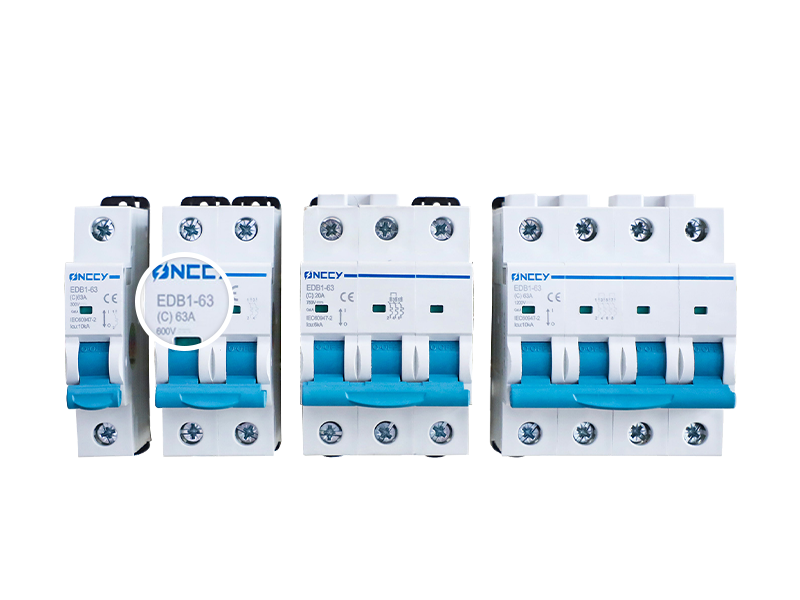Introduction
Miniature Circuit Breakers (MCBs) may look simple, but choosing the right protection curve can be complex. Why do devices with the same rated current still have B, C, D, K, Z, or DC labels? How do thermal and magnetic trips differ? And why does ambient temperature affect tripping behavior?
This guide breaks down everything you need to know about MCB protection curves so you can select the right breaker for your load conditions and avoid costly mistakes.

What Is a Protection Curve?
A protection curve is a time-current characteristic curve that shows how quickly an MCB trips when current exceeds the rated value (In).
At 1.13 In: the breaker must not trip within 1 hour.
At 1.45 In: the breaker must trip within 1 hour.
At 2.55 In: the breaker must trip within minutes.
This ensures normal loads run safely, while overloads and short circuits are properly interrupted.
Thermal Trip vs. Magnetic Trip
Thermal Trip:
Uses a bimetal strip that bends when heated by overcurrent. It provides overload protection (seconds to minutes). Thermal trips are sensitive to ambient temperature.Magnetic Trip:
Uses an electromagnet to open the circuit instantly during a short circuit. It reacts within milliseconds to prevent damage.
How Ambient Temperature Affects MCBs
Ambient temperature influences thermal trips. If the enclosure exceeds 35–40°C, the breaker may trip too early. Solutions include:
Using the next higher rated current (In).
Choosing adjustable thermal-trip models.
Improving panel ventilation and cooling.
Understanding the MCB Curves
Each letter corresponds to the instantaneous magnetic trip range:
B Curve (3–5 × In) – Sensitive, ideal for resistive loads like lighting and sockets.
C Curve (5–10 × In) – Standard choice for small motors, air conditioners, pumps, fans.
D Curve (10–20 × In) – Handles high inrush current, for large motors, transformers, UPS.
K Curve (8–12 × In) – For industrial loads with frequent starts like compressors, rectifiers.
Z Curve (2–3 × In) – Extra sensitive, for PLC, electronics, rail systems.
DC Curve – Specially designed for photovoltaic and energy storage systems. Uses DC arc-extinguishing design and must not be replaced with AC types.
⚠️ Misconception Alert: Higher multiple ≠ better protection. Using a D curve for small loads may prevent the breaker from tripping during a short circuit.
Why Measure Inrush Current Before Selection?
Many loads draw a high inrush current at startup:
Incandescent lamps: close to rated current.
Motors and compressors: 5–10 times rated current.
If you ignore inrush current, a too-sensitive curve (e.g., B) may trip unnecessarily. Always measure or estimate startup current before selecting the curve.
Check Minimum Short-Circuit Current
The breaker must trip reliably during a short circuit. A rule of thumb:
Minimum short-circuit current ≥ 1.25 × lower limit of the curve.
Otherwise, the breaker may fail to trip under fault conditions.
AC vs. DC Circuits
Never use AC MCBs in DC circuits.
DC arcs are harder to extinguish.
PV, EV charging, and energy storage systems require dedicated DC MCBs.
Common Selection Mistakes
LED lights trip the breaker → B curve too sensitive. Switch to C or add surge protection.
Motors trip on startup → Curve too low. Use D or K curve, or add soft start.
Summer heat causes frequent tripping → Panel too hot. Use higher In or improve cooling.
Using AC breaker in PV/DC systems → Dangerous. Always use DC-rated models.
Step-by-Step MCB Selection Guide
Determine rated current (In) based on conductor size and temperature.
Check inrush current of the load to select the right curve (B/C/D/K/Z/DC).
Verify short-circuit current is above curve threshold × 1.25.
Adjust for ambient temperature if enclosure >35°C.
Validate on-site performance and fine-tune if needed.
FAQs
Q1: Why do I need different curves for the same rated current?
Because loads behave differently. Motors and electronics need higher or lower sensitivity than resistive loads.
Q2: Can I replace a B curve with a C curve?
Yes, if the load requires tolerance for higher inrush current, but ensure short-circuit protection is still reliable.
Q3: How do I know if my panel is overheating?
If MCBs trip frequently in summer without overloads, measure enclosure temperature. Anything above 35–40°C requires adjustments.
Q4: Can one MCB type cover both AC and DC?
No. Always use DC-rated breakers for PV or storage systems.
Q5: What if the breaker never trips?
It may be oversized, curve selected too high, or minimum short-circuit current too low. Recalculate and adjust.
Conclusion
Choosing the correct MCB protection curve is critical to balancing safety and reliability in electrical systems. From household lighting to industrial machinery and solar power systems, each application demands precise selection based on inrush current, short-circuit levels, and ambient conditions.
At ONCCY, we specialize in electronic protection components, including AC and DC miniature circuit breakers, surge protective devices, and PV protection solutions. We provide expert guidance and customizable products to fit your exact application.
Contact ONCCY today to discuss your project and find the right MCB solution for your needs.
